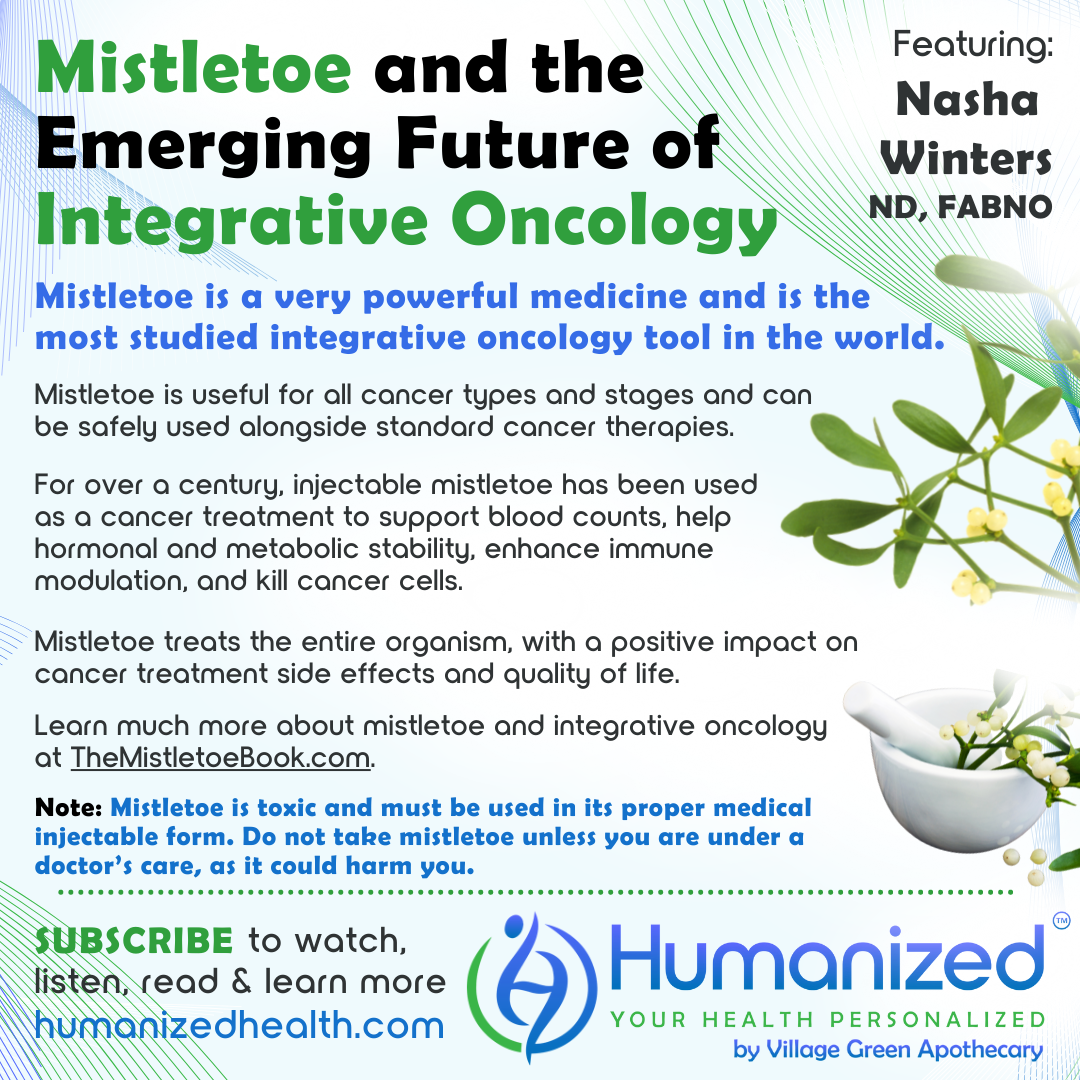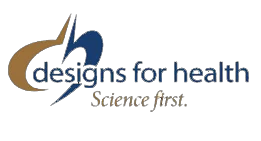Mistletoe and the Emerging Future of Integrative Oncology
Featuring
Nasha Winters, ND, FABNO
WATCH
LISTEN
READ
Rebekah Kelley: Welcome to the Humanized podcast, all about personalizing your health. I am your host, Rebekah Kelley, and today we’ll be discussing Mistletoe and the Emerging Future of Integrative Oncology with Dr. Nasha Winters, naturopathic doctor. Before I introduce Dr. Winters, I want to remind everyone to subscribe and get all of the variety of casts in audio, video and transcription at HumanizedHealth.com. I’d also like to thank our lead sponsor, Village Green Apothecary, at MyVillageGreen.com.
Dr. Nasha Winters has been on a personal journey with cancer for the last 30 years. Her quest to save her own life transformed into a mission to support others on a similar journey. From survivor to physician, and from physician to mentor, Dr. Nasha is teaching physicians and practitioners how to treat cancer with an integrative approach that focuses on the patient and not on the tumor. Now Dr. Nasha Winters is on a mission to build the first inpatient integrative facility focusing on the terrain-based metabolic approach to cancer treatment.
Dr. Nasha, thanks so much for being with us.
Nasha Winters: So good to be with you guys again. Thank you for having me.
Rebekah Kelley: It’s always a pleasure and we’re so excited to talk about your new book, Mistletoe. You co-authored Mistletoe and the Emerging Future of Integrative Oncology, which has just been released in November of this past year. Hold it up….
Nasha Winters: I’ve got my book here. I’ll have to change my [Zoom] backdrop for you. There we go.
Rebekah Kelley: So that’s what the front of it looks like. And mistletoe or VAE [Viscum Album Extract, or European Mistletoe] therapy is a very hot topic with integrative cancer treatment. You can read more about the book at www.TheMistletoeBook.com. So that’s the URL for more information.
So, thanks for being here with us. Can you just go ahead and provide us with a brief history of the use of mistletoe in regards to treating cancer?
Nasha Winters: Sure. Mistletoe’s this beautiful… though most people think of it coming out of the holiday season, of the kissing plant, just something you kiss under the mistletoe. But it goes way back. It goes way back into the druidic times and whatnot, and it had sort of a mythology around it, being something that you could take of the mistletoe and sort of visit the underworld. It had this mythology around sort of resurrection and visiting those who passed on. And then later it also had an interesting history in that it’s a plant that is a semi-parasitic plant, that it never touches the ground. It grows inwards to its center. It flowers in the winter, which doesn’t happen [much] in the plant kingdom. And it grows incredibly slowly, the leaves, like two leaves per summer.
So it’s a very unique creature in the plant world. And so it was recognized as such and used for thousands of years, for things like pain patterns or arthralgia, for epilepsy, for migraines, it was used for spleen disorders by Hippocrates. The thing to keep in mind though, is for all those years, it was used as a whole herbal tincture. And in knowing this, so your people who are listening to this right now, it’s toxic. So we don’t want anyone to go out and harvest some mistletoe growing in the tree in your backyard and drink this, cause it could kill you. Because as is true for many plants that have some anti-cancer qualities, they tend to be very toxic, which is why they can be so toxic to our cancer cells.
So fast forward, about 100, 101 years ago, an interesting philosopher by the name of Rudolf Steiner. Most people know of his work. If you are familiar with Waldorf education or permaculture in the agricultural world, or even anthroposophical medicine. And so it’s from his philosophy that these things infiltrated our culture in our society today. And he was a keen observer and noticed this concept known as the “Doctrine of Signatures,” which is something looking like, for instance, you look at a walnut and you go, gosh, it kind of looks like a brain. Would that be good for the brain? Which yes, it is, actually. Same type of thing he was observing back in nature, to look at these little balls of plants growing in trees saying, oh, it kind of looks like a tumor. And the tree, I wonder if this would be good for tumors.
So lo and behold, he partnered with a woman named Ita Wegman, medical doctor, and in 1917, they started to apply this to the cancer environment, to the cancer patient. Ironically, they somehow knew that you needed to harvest some of the fruiting berries of the winter and some of the summer leaves, and blend them up, and then trickle in a [lttle] water, almost a homeopathic infusion. How in the world they knew that, I will never know. And then they also had the wherewithal to say, hey, we shouldn’t ingest it orally. We need to inject it.
So it’s been used for over 101 years as an injectable therapy, be it subcutaneously, intravenously, intratumorally, intraperitoneally, all over the world for 101 years as a consistent therapy in the treatment of cancer. And historically it has been used in partnership with standard of care, so used right alongside with your chemo, your radiation, your surgical intervention, today, your targeted therapies, your off-label drugs, your integrative therapies. So it has that utility and has for over a century now. And it’s sort of like our early adopted immune therapy. It’s a very powerful medicine, the most studied integrative oncology tool in the world. And probably the most tolerated, and probably the most affordable in many ways.
Rebekah Kelley: Wow. Wow. I had no idea.
Nasha Winters: Blows people’s minds. Yup.
Rebekah Kelley: That is amazing. What a rich history. And of course, I do, as you said, I know mistletoe as the, you know, you’re allowed to kiss whoever you want underneath it. So, you know, it certainly is a plan I’ve appreciated [both laugh]…
Nasha Winters: Of course!
Rebekah Kelley: But now there’s this whole other understanding and appreciation of it as it relates to my health. So what are some of the ways that mistletoe therapy can improve a cancer patient’s health and quality of life? How does all this knowledge affect that?
Nasha Winters: What’s interesting is, again, this was observed in nature and they started to apply it and it was sort of after the fact they started to do the research to what the heck was it actually doing? Because people were getting better. So what they started to find – again, what I love about this therapy, so many of our therapies are not able to partner well with other pharmaceuticals, other drugs – mistletoe has virtually no contraindications, no interactions. The few that there are, are trained into the physicians, so they know how to work with this. But it’s incredibly well tolerated and incredibly well paired with other therapies.
But what we’ve been able to elucidate in the research, both in cell line studies into animal studies and into good, robust human studies, is that it definitely overcomes the pancytopenias. So, the low blood counts, the low white blood cells, the low platelet counts. It helps prevent that from happening when you’re taking therapies that are known to drive those numbers down. It helps with the toxicity profile. So it helps protect the kidneys and the liver very specifically from the toxicity of a lot of the therapies that have to be processed through those organs of elimination. And so it helps sort of preserve their integrity as well. It has potential, and like DNA repair of your healthy DNA, it induces apoptosis in your unhealthy cells. It lowers angiogenesis, which is the new vascular shunting of resources over to the tumor and away from the healthy body, so it lowers that potential, as well as even a measurable value of something called VEGF, vaso-endothelial growth factor. You can actually measure that number improving with the use of this medication. It lowers interleukin-6, C-reactive protein, all of those inflammatory markers, inflammatory cytokines.
But the coolest thing I love about this medicine is that it has direct impact on people’s quality of life. So some of the most powerful studies that are out there on this plant is its impact on fatigue, like cancer treatment related fatigue, cancer related fatigue, and also depression, anxiety, sleep disorders, digestive disorders that go hand-in-hand with this type of diagnosis and the treatment for this diagnosis. And so one of the coolest things is we have patients who are just qualifying saying, I subjectively feel better. And survey after survey, we see this. Some of the reasonings, we think it might be raising endorphin levels, endocannabinoid levels, which of course are going to have an impact on how we feel and how we see and perceive the world around us. So it’s got a very far reach and it plays so well with other therapies that it seems remiss to me not to bring it onto the patient experience somewhere along their cancer journey.
Rebekah Kelley: Wow. I’m so glad you’ve collaborated on this and providing this as an opportunity for people to really understand. Then, I mean, in the quality of life, if you have depression, if you’re feeling sad, like if you’re able to enhance and create a better quality of life, we know that that helps with the process of healing. Right? So what a beautiful little partnership.
You’ve laid out all those wonderful benefits. I mean, is mistletoe therapy a good fit for all cancer patients? Are there some that are a better fit than others? How would someone be able to make that determination for themselves?
Nasha Winters: What I love about the approach with mistletoe is that it’s treating the entire organism. So it’s helping, as I said, the blood counts, it’s helping hormonal stability and metabolic stability, immune regulation and immune modulation, the quality of life piece we talked about here. So it’s helping the whole organism come into balance, and to come into being able to accept whatever treatments are coming its way. So with that being said, that always increases positive outcomes with whatever therapies come on board. So we find that it is a useful tool across the board for all cancer types, all stages.
The other thing though, is where it has an actual cytotoxic effect, meaning cancer killing effect. And that’s based on particular components of this plant known as lectins, polysaccharides and viscotoxins. So the “toxic elements” we talked about in a lot of our anticancer therapies are actually anticancer themselves. So an example is, Pacific yew tree for instance, is now used today as Taxol, the taxane family in chemotherapy. Or periwinkle, vincristine and periwinkle, these are used in a lot of the conventional chemotherapies today. So these viscotoxins are the anti-cancer killing component of the mistletoe. And there are seemingly effects in all cancer types, but the most responsive, where the studies have shown the bulk of its benefit, is in the GU cancers, the gastro urinary tract cancer. So anything like colorectal cancer, anywhere basically along that tube, anything in the gynecological or urological based cancers – definitely helpful. So we see it in prostate, ovarian, uterine, renal cell carcinomas, bladder cancers. In fact, we even do infusions. We actually put it right into the bladder, very profound treatment. And we work with a urinary, a uro oncologist out of Baylor, actually, who monitors our patients going through this treatment and is just astonished by what he sees in this patient population.
So it has beautiful utility across the board. There was a time when a lot of people didn’t think it was effective for things like blood cancers, such as lymphomas, leukemias. It has a very powerful role in lymphoma, and then there’s different forms that actually can be beneficial for other things like leukemias, as well. So it has kind of a broad stroke across the board.
Rebekah Kelley: So considering that it does look like it’s pretty good for most or all patients and the benefits… does it matter when mistletoe therapy is integrated into a treatment plan? Does it make a difference? And then, obviously we’re always wondering, are there interactions or side effects for anything that you do, especially since you said it can be very toxic.
Nasha Winters: Exactly. Yeah. Toxic in its whole plant form with someone who’s just trying to apply this to themselves. But used in its proper medical, injectable form through a physician’s recommendation and prescription, incredibly safe profile. And then across the board, as far as… oh my goodness, I kind of hit that second question, but what was the first part of it?
Rebekah Kelley: Is there, cause a lot of times your treatment plan, it matters when you’re going to implement it. Does it matter when you’re going to implement this as part of a treatment plan?
Nasha Winters: I think I blanked on that because I just use it wherever. If someone comes to me, whether they’re just diagnosed and haven’t started treatment, they’re coming to me after treatment is complete and they’re looking just to clean up and fortify their body. They’re looking to get support while they’re undergoing standard of care treatment… this is the beauty of this therapy. It does not [matter.] You can even start it the morning of your surgery. You can have it the same day you get your chemotherapy. The same day you get your radiation. That’s how safe this profile is and how well it works with patients. So that’s where we can bring it in and train practitioners to learn when the best time for their patients is, because sometimes we’re mixing up with other therapies too. But ultimately, there is no wrong time to bring it onboard. You might want to be careful when someone’s having a fever. You don’t want to use it at that time. If you have too strong of a reaction when you bring it onboard, you may want to lower the dose and time it differently. But ultimately it’s an incredibly safe and useful therapy to bring on to any part of the cancer journey.
Rebekah Kelley: How would you… I mean, I haven’t heard of this before and I don’t know how many people have. So, what do you see in terms of the future of this as a therapy and an integrative cancer care, how would you like to see this grown? And what’s your vision for how the message would get out? Do you think a lot of people diagnosed with cancer know about this, or how would they find out this information? And what’s your vision of the future? Because this is all about personalized health. And how do you see this as part of that solution?
Nasha Winters: Well, the beauty is over the rest of the world, this is part of standard of care. It’s not considered either-or, we’re just behind here in the west. We’re behind here in the United States. The first clinical trial of IV application of it just completed at [Johns] Hopkins, which was a safety trial, and now it’s moving into phase 2. There are multiple other trials getting ready to start in the next year. They were a little behind because of COVID – everything is a little behind in the research realm. What you’ll find in the book though, is that it’s loaded. We’ve got hundreds of references. The website, TheMistletoeBook.com, has ongoing… we’re constantly adding new research of what’s happening all around the rest of the world. This is used in hospitals around the rest of the world. It’s used in intravenous, intratumoral applications around the rest of the world. So it’s already sort of standard elsewhere. We’re trying to change that for here, on our soil, here in the U.S., and make this more available.
So this book was written by myself and six other colleagues who’ve been using this therapy for decades, from all over the world – from myself as a naturopathic oncologist, to one of my colleagues, who’s on the book, who’s a hematological oncologist. So the scope of our experience and how we use it – she does it in a hospital environment, I did it in a little small clinical environment. But the book is basically a beautiful tool for the physician or for the patient to hand to their physician and say, I want you to learn this and apply this to me. We’re trying to make it a good standard of care, and helping people understand and be educated. And the proceeds of the book are going into further research, as well as further education of physicians to be able to use this effectively for their patient population.
Rebekah Kelley: Wow. Thank you so much. Dr. Winters. That’s so beautiful. And thank you for the book. I’m so excited that you now are bringing this collaboration with other colleagues and people around the world to share the information that’s going to help people get better. Those are really valuable insights. Dr. Winters can be found at www.DrNasha.com. I’m going to spell that. It’s Dr. N A S H A.com. And let me remind you to subscribe, to get all access to Humanized videos, podcasts and transcriptions from all of our thought leaders, like Dr. Nasha, on personalized health at HumanizedHealth.com. Thanks so much for being with us.









